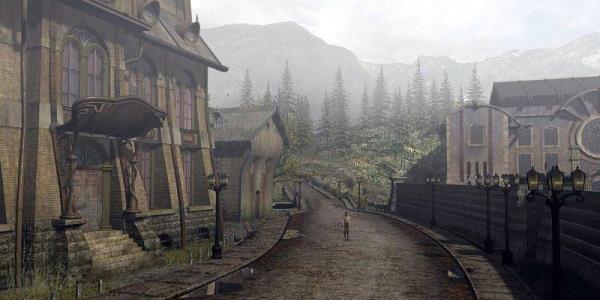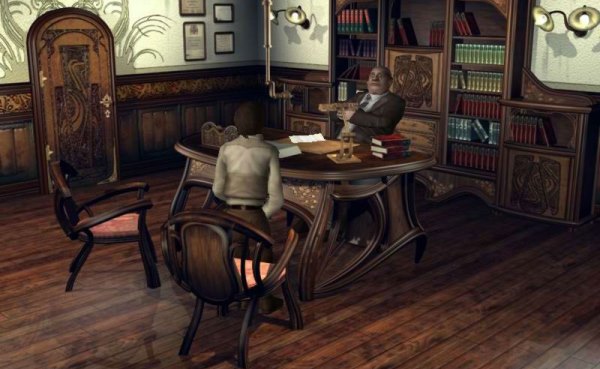Syberia PS3 Review: Clunky, But Still Quality

Back at the turn of the century, one adventure game rose to the top of the pack to earn a spot among the most beloved PC games of all time, Syberia. Perhaps spurred on by the genre’s recent resurgence, Syberia has made the jump to a more modern platform, recently releasing on the PlayStation 3. But even with a few modern tweaks thrown in for good measure, can a game made more than a decade ago still capture the imagination of modern players?
Despite quite a few technical hurdles, the answer to that question is yes, so long as you’re willing to put up with some antiquated design. I missed out on Syberia the first time around, so I didn’t go into the game with nostalgia goggles to tint my current experience. Despite that fact, I found the beautiful narrative and still-lovely visuals to be more than enough to drag me along the game’s 10-hour storyline, even if I did experience occasional moments of controller-snapping frustration.
Originally published in 2002 and the brainchild of Benoit Sokal, Syberia is an intriguing look at history and the impact it has on all of our lives. Just because something is outdated doesn’t make it obsolete, which is an appropriate enough message considering the game we’re talking about; a classic PC title that still manages to do some things very well, even if it goes about those things in a rather clunky fashion.

In Syberia, you play the part of Kate Walker, a law firm representative visiting the French Alps on a quest to close a major deal for one of her firms’ clients. The story begins in Valadilene, home of a legendary manufacturing company known for its clockwork toys, puppets and automatons. The Universal Toy Company wants to buy the failing factory, currently owned by an aged woman.
Upon arriving in Valadilene, however, you quickly discover that the factory’s proprietor is recently deceased, thinking that now would be a great time to let the world know that a mysterious heir actually exists. This is a bit of a problem for Walker, as she must now track down said heir in order to complete the sale of the company. To do that, you’re going to need to visit a few countries spread across the continent and, this being a puzzle game and all, solve loads of puzzles along the way.
Said puzzles are usually logic driven, even if their various components are anything but. Why is that one door’s key in a fountain? Why can’t the main character just step into the pond and grab the oar herself? Why are this machine’s main components spread hither and thither? Thankfully, the world of Syberia is a bit off of the norm to begin with, so all of these odd set-ups actually fit in with the game’s fiction just fine…ish. So, for the most part you’ll be running back and forth between locations, using things you saw earlier to trigger events later, combining components and figuring out the true purpose of many contraptions. There’s a bit too much backtracking to suit me and some of the components you need are tricky to spot but, once you get into the flow of the game, everything starts clicking into place nicely.

While the original Syberia was a point and click adventure, the PS3 version of the game has the player fully controlling Kate’s movement. This actually may have been a big misstep. Moving the character around in a 3D space means you’ll be doing an obnoxious amount of pixel searching in a method that isn’t as well suited to the task as simply clicking on the things that catch your attention. The world is also full of weird bits of geometry, meaning you’ll constantly find yourself stuck on an invisible barrier, running around in circles or back and forth until you find the right angle to get past a certain area. That frequently led to me assuming that I say, couldn’t head left, leaving me to look up a FAQ from time to time in order to find out I just needed to try a few more times until Kate finally continued onto the left screen.
Your Daily Blend of Entertainment News
Pretty quickly I was reminded of some of the most basic rules of classic adventure games: Talk to everyone and take every dialogue option, explore the world, explore it again, then maybe explore it a third time just in case the “interact” option didn’t pop up the first couple of times. One of the nicer added features is a difficulty setting that lets you pick “no hints,” like the game was originally played, some light hints that will guide your exploration, and even a step by step guide to get you through the puzzles. If you can’t quite swing it in one mode, there’s no shame in taking the difficulty down a peg in order to spare yourself some rage.
If you can look past frustrating controls and settle into a simpler adventure game mindset from a bygone era, then you might find a lot to enjoy in Syberia for the PS3. The settings are still wonderful to look at even if the character animations are a bit awward. And while the controls could use a more thorough retooling, the story is a genuinely unique yarn that’s worthy of all that praise that was heaped upon the game 12 years ago. With so many
>new adventure games popping up these days, Syberia is a great way to explore the genre’s rich and rewarding history. If nothing else, it should help get you ready for Syberia 3, which is—last I heard—still headed our way sometime next year.
This review based on a PlayStatoin 3 download copy provided by the publisher.
Players: 1
Platforms: PlayStation 3
Developer: Anuman Interactive
Publisher: Nordic Games
ESRB: Everyone
Rating:

Staff Writer for CinemaBlend.

